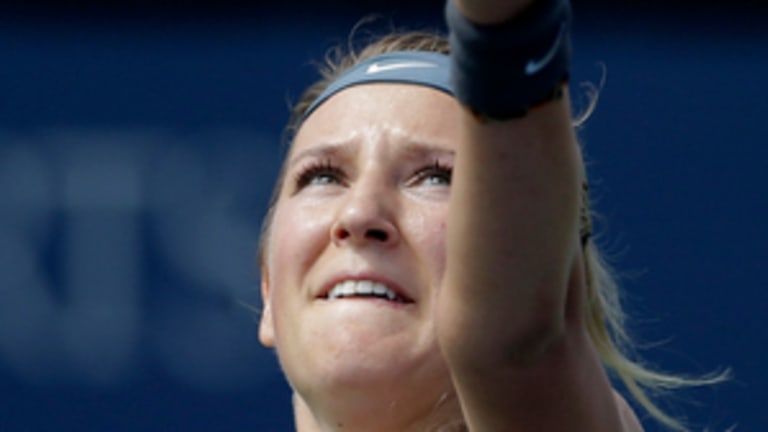Each day this week, Peter Bodo will review action from Cincinnati and preview upcoming matches. These "Good Morning Cincinnati" posts will be published around 10 am EST, and we encourage you to discuss the day's play—along with Pete's thoughts—in the comment section below.
Yesterday: Last week seemed remarkable to me, and not only because it was such a historic one for Canadian tennis. Long considered a backwater of the sport, the nation has some fine, up-and-coming players, and today Milos Raonic becomes the first Canadian in the history of the ATP rankings (which began in 1973) to make the Top 10.
But I’m also thinking about how much tennis coverage has changed over the years. As little as 10 years ago, getting live coverage in the U.S. of a tennis event in Canada seemed a hopeless fantasy. This week, we had simulcasts from the two venues where the Canadian Open was played out.
The broadcasts were so well handled, so seamlessly integrated into each other, that if one sign behind the baseline didn’t say “Rogers Cup” (Toronto) while the other read “Coupe Rogers” (Montreal), you might have been convinced that the men and women were playing in the same venue.
Now to the finals. Remember the outstanding facet of Rafael Nadal’s game in 2010, when he won his lone U.S. Open (and career-Grand Slam)? It was his serve. Even Nadal professed amazement at how well he suddenly served throughout that fortnight. While he didn’t necessarily serve as well yesterday in Montreal—and Raonic certainly needed to go into the shop for some serious work on his service return—the role Nadal’s serve played in his win was striking, and perhaps even a harbinger. Nadal looked better than any of his elite peers in Montreal, by far.
One of the other takeaways from Montreal may be that, in a weird way, Roger Federer has been the glue that bound and held together this vaunted Big Four.
Granted, because of the ranking system and the luck of the draw, Nadal ended up in the same half as Novak Djokovic. But the loss by No. 2 seed Andy Murray and the continued unreliability of David Ferrer (the No. 3 seed got just six games off journeyman Alex Bogomolov Jr. in the second round) laid out a red carpet for first-time finalist Raonic.
And where were Tomas Berdych, Jo-Wilfried Tsonga (OK, injured), and Juan Martin del Potro? Good question. Without Federer around to keep peace in Dodge, everything got a little western. Was it just coincidence, or a manifestation of a weird form of synchronicity? We’ll be more able to judge after this next week in Cincinnati.
But be warned, Federer, Djokovic, and Murray fans: Nadal looked terrific in Montreal, and played more alertly and opportunistically than any of the usual suspects without having any notable advantage going in. Seeded just No. 4, Nadal told a lot when he reflected: “I was just trying to play aggressive. And when I’m feeling the ball, it will always be easier to be aggressive. If I’m not playing well and must be two, three meters behind the baseline it’s hard to win from there.”
In Toronto, to the surprise of absolutely no one, Serena Williams crushed Sorana Cirstea in the title match. It was Williams’ 56th win of the year (balanced against three losses); she’s now won 44 of her last 45 matches. Most telling, though, is that she’s 11-1 against fellow Top 10 players this year.
Cirstea is a game player who isn’t afraid to club the ball. Give her credit for standing toe-to-toe with Williams and trying to slug her way through. It certainly worked against a truly impressive succession of opponents: Caroline Wozniacki, Jelena Jankovic, Petra Kvitova, and Li Na. Every single one of them is a former No. 1 or a Grand Slam champion. When was the last time a player outside (or perhaps even within) the Top 10 accomplished anything like that?
What chance Cirstea had of banging Williams off the court rested on her ability to take advantage of every opportunity. Had she started strong and put pressure on Williams, who knows? And for sure, Williams was less than formidable until she had Cirstea pinned in the rear-view mirror by the third game of the second set.
But Cirstea got off on the wrong foot, double-faulting twice in the first game to yield a break, and in the blink of an eye she was behind two breaks, 0-3. In truth, the score could just as easily have been reversed—Cirstea had a deuce in Williams’ first service game of the set, and she broke her to wipe out one of those breaks.
But Cirstea just wasn’t consistent or bold enough to exploit her chances and take command. In some ways, this was one of those blow-outs that shows mostly how quickly a snowball becomes an avalanche when an underdog doesn’t convert her chances against a top player.
And in news from qualifying in Cincinnati, Canada’s promising youngster Eugenie Bouchard, and Annnika Beck, Bouchard’s German counterpart in the prodigy division, both survived qualifying, as did another, veteran German, Andrea Petkovic.
On the men’s side, Mackenzie McDonald—an 18-year-old Californian so off the radar that the ATP website has nothing on him other than his April date of birth—is through to the main draw. He qualified with back-to-back wins over a pair of Top 100 players, recent Newport champ Nicolas Mahut and former collegiate star and promising pro Steve Johnson.
Finally (for some reason), the Cincinnati Masters offered two main-draw men’s singles matches: Julien Benneteau knocked off Marcos Baghdatis in straight sets, and Ryan Harrison got off to a great start with a win over Alexandr Dolgopolov.
*
